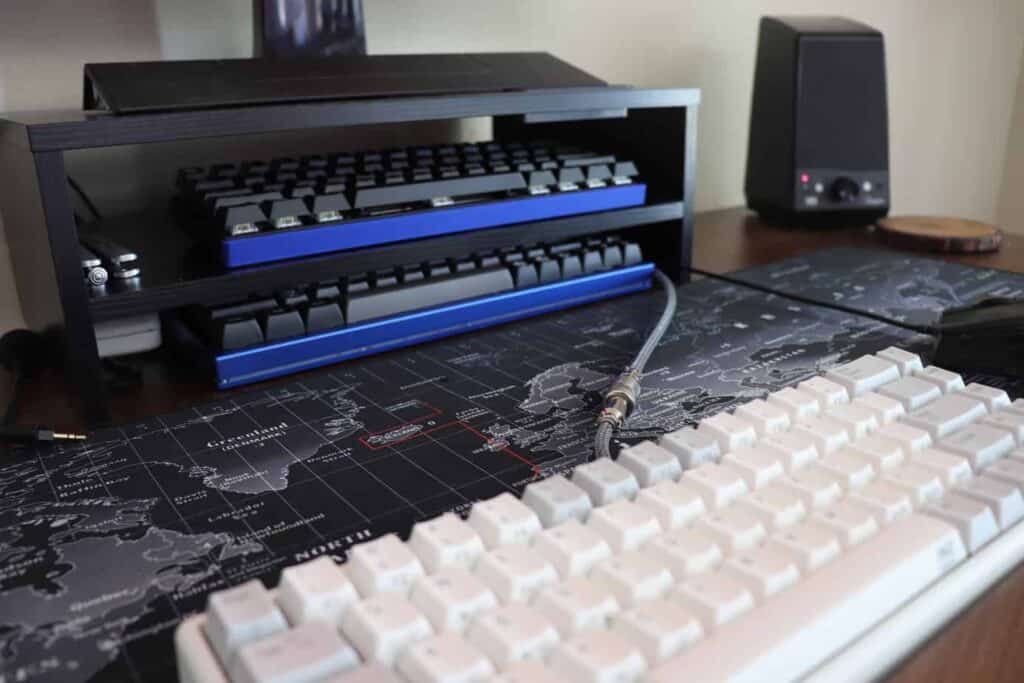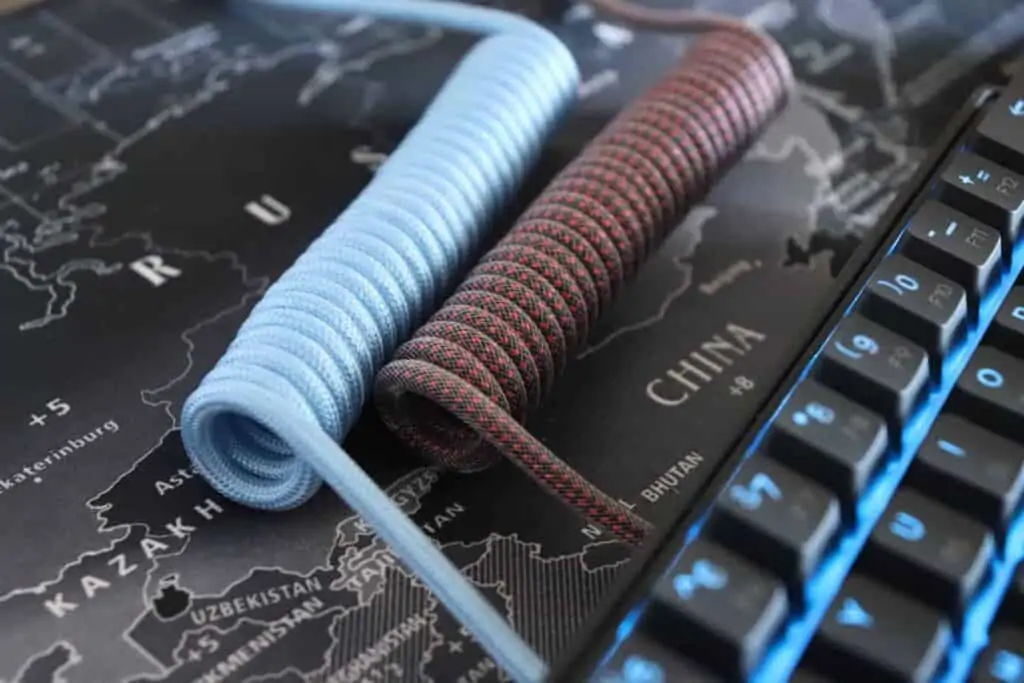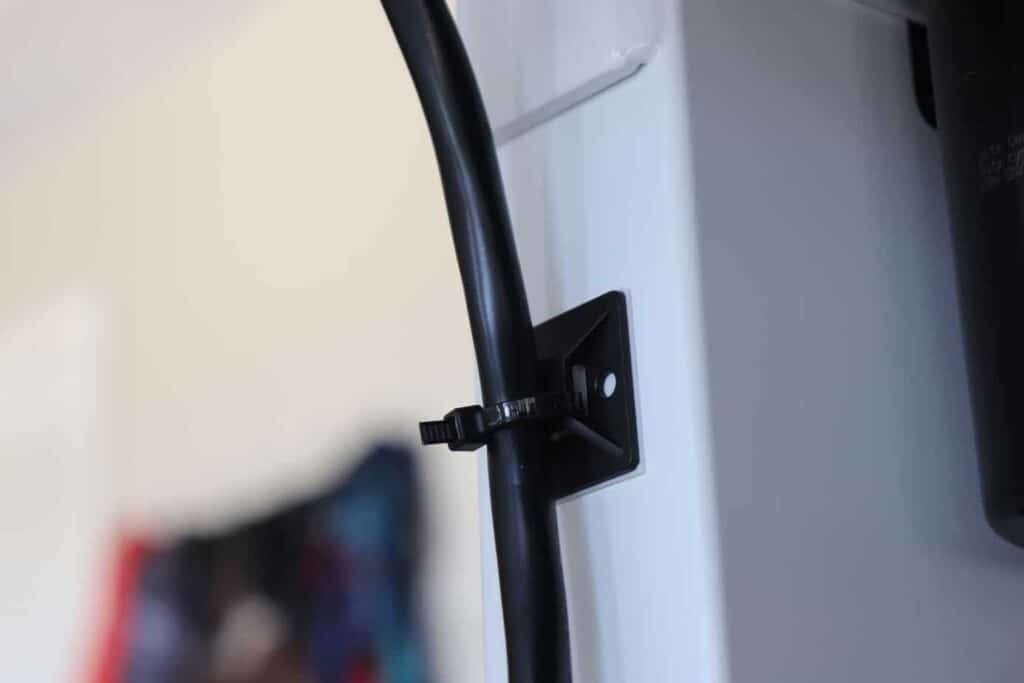In the struggle to achieve the ideal workspace, cables are the enemy. They get in the way, look awful, and keep you tied down.
They may be a necessary evil, but that doesn’t mean you have to look at them.
In this guide, we’re going to show you 8 methods to help you conquer cables.
Method #1: Keyboard and Mouse Tray
A Keyboard and mouse tray is a classic feature in many computer desks. They help with improved typing posture, but also with hiding and managing your cables.
Since your keyboard and mouse will now essentially be under your table, you have an easy way to hide and manage your cables.
You can purchase a tray from many local and online retailers. Some may require drilling, while others include clamps to attach to your table.
Once the tray has been installed, you can manage your cables any way you wish. I recommend using some adhesive cable ties or silicone cable holders under your desk to lead them to your tower while avoiding drooping.
Method #2: Monitor and Keyboard Stand

These not only raise your monitor and keyboard, but the keyboard tray serves a similar purpose as the one above, allowing you to route your cables underneath and to the back of the desk.
After setting up your stand, all you need to do is neatly run your cables to the back of the desk and manage as you wish. The monitor stand portion can help hide your cables.
Method #3: Custom Cables

If you can’t completely hide your cables, you can at least make them more appealing or more manageable.
The obvious option may a cable be straight to the back of the desk behind your monitor and routed to your tower.
If your tower and monitor sit on the same desk, you may find the most ideal position for the cable is to run between them.
Your best bet may be a cable with right angle plug that leads your cable to either edge of the desk, or under the tower and fed to the rear jacks.
A coiled cable usually includes two right-angle bends which may provide you with a cleaner way to route your keyboard cable.
This also gives an extra level of customization and visual flair, which may help snazz up your setup by embracing and highlighting certain elements rather than hiding them away. A good allegory for life.
Method #4: Manage your Cables

You may find that you simply can’t avoid or don’t mind having cables on your desk. Here are some items you can use to help manage your cables even if they won’t be invisible.
For your Keyboard and Mice Cables
These can also be used with any of the above methods to help keep your cables neat and out of the way. A thick band of gathered cables often looks better than multiple stray cables.
- Zip ties or cable ties with or without adhesive to tie up your stray cables and stick them under or behind your desk.
- Velcro tape is another option which perform basically the same task.
- Large binder clips. If your desk is 3/4″ or thinner, you can probably clip some jumbo binder clips to the sides and use them to help keep your cables both separated and tethered to the desk. This is most handy for things like chargers, mice, headphone, and speaker cables. You can arrange the clips how you like and thread your cable through the handles.
- Sugru / adhesive silicone cable holders. A more custom but secure way to tidy your cables.
- Any custom solution with Command Strips. Command Strips provide for cleaner removal than many of these other adhesive methods and allows for more customization. One example is a binder clip with or without handles removed, secured to the bottom or edge of the desk with command strips. Used for running cables through from one end to the other.
Mounting any of these to the back or side of your desk can help keep your cables looking tidy and reduce excess slack. They can also help your cable from hanging too much and stressing the plugs.
Dealing with Monitor and Tower Cables
Using the following items, paired with any of the techniques or items above, you can really transform and hide how the cables look. You may not always be able to avoid having multiple arcs of cables flowing from the rear of the pc, but you can hide everything in between.
- Cable sleeves will gather up all your cables, or specific groups of cables, and cover them in a flexible tubing. This will help keep them tody and collected, reduce overall cable strain, and match it to any color scheme you like.
- Cable raceways. These plastic cable covers help by instead covering your cables with a more protective cover. These are designed to run along corners, edges, and floors. They will help you from having unsightly cables hanging and running all over the walls and floor, and keep you from tripping on them or needing to avoid them.
- Cable trays can be mounted to the back or rear of your desk. If you cannot avoid having cables hanging behind your desk, at least you can save them from dangling and being in the way. These trays allow you to roll up any excess cable and stash them out of sight.
If your table has a solid back, you can also drill some holes in the back to route and contain your cables.
You can pair it with cable trays mounted underneath your table, Power strip/UPS, or any of the velco/cable tie options.
Method #5: Go Wireless
Obviously, the best and albeit most expensive way is to cut your cables and go wireless.
Wireless peripherals give you relative freedom to arrange your workspace and desk space as you will.
Be aware that polling rates and latency may affect your experience negatively, causing not only input lag, but also visual lag if the polling rate is lower than the refresh rate of your monitor (ie: 125hz polling rate mouse to 144hz refresh rate monitor).
Wireless Connection Speeds: Bluetooth vs 2.4GHz
Bluetooth is a common option now in the Mac and mobile setups without the use of usb reciever dongles. Keychron, Epomaker, Akko, Ducky, Keycool KC84 Bluetooth, are among the better bluetooth-enabled mechanical keyboard options.
2.4ghz technology, while requiring a paired reciever dongle, performs much better with less latency.
The downside of 2.4ghz wireless is that if you have too many peripherals using it, you may get unstable connections and performance. Some noteworthy 2.4ghz keyboards include the Keycool KC84 Wireless and Durgod Fusion.
Logitech Lightspeed and Razer Hyperspeed have massively improved the wireless peripheral game.
The low-latency signals perform extremely well, even for gaming. While you may not be a fan of the keyboards, the mice are undoubtedly good performers. Glorious Model O wireless is another worthy contender.
Wireless Displays Are An Option
As far as displays you could go for a projector. There are now even options for completely wireless displays and monitors like the Dell S2317HWi. Other than your tower, it would be possible to have a completely wireless desk setup.
This is probably one of the more expensive options, assuming you don’t already own any wireless peripherals, but also does not force you into any particular desk layout.
As some gamers and power users tend to change their setup and keyboard angle depending on the game or task, drilling holes may be too limiting, unsightly, and cause excessive wire drag for gaming mice.
Paired with a clean PC and desk setup, you look to cut wires from your memory entirely.
Method #6: Drill a hole in your desk
An extreme custom method is to drill holes in your desk. It is best to wear a mask while doing this.
Tools you will need:
- Mask (recommended)
- Eye Protection (recommended)
- Gloves (recommended)
- Power Drill (required)
- Hole saw bit or drill bit (required)
- File/Rasp (recommended)
- Tape (optional)
- Bag or cardboard box (optional)
- Vacuum cleaner (recommended)
Step 01
Find a sweet spot for your keyboard placement. The spot you choose to drill your hold will determine where your keyboard and mouse cables will emerge, and where you can place your peripherals
Step 02
Protect your electronics with plastic bags or covers. Tape a cardboard box or bag to the bottom of the desk, under the hole you are about to drill to help catch wood and dust.
There will be a lot of wood shavings flying around and accumulating on the desk, so be sure to move everything out of the way and cover up anything you need to. Have a vacuum cleaner handy for the aftermath.
Step 03
Put on your goggles and mask.
Step 05
Drill or boar a hole large enough for your USB cable to pass through, making sure you have the right sized attachment and your drill is spinning in “righty-tighty”.
Make sure your drill is charged if it has a battery, and the torque on the highest setting. Gradually start up your drill and apply downward force to your drill. Depending on the hardness and thickness of your table, as well as power of your drill, this process may take a few minutes.
The size of the hole you drill is up to you. You can have either a large circular hole, or a hole sized and shaped specifically for your cable’s plug to pass through. This will determine whether you should use a hole-saw bit or a regular drill bit.
Step 06
(optional) If you have a deskmat, place it over the hole in the normal position. You can now choose to pierce or cut a hole into the deskmat above the hole, which will not only help hide it but also keep your cable in place. This works best if you have a black deskmat, or one that matches your cable color.
Step 07
You can now route and manage your cable under your desk. Repeat this for your mouse cable if you have one.
Method #7: Add a USB port to your desk
The next step up from drilling holes is to drill a specifically sized hole meant to house a port, so that you may run a USB extension cable from your PC to your desk, and plug in directly to your desk rather than worry about cable management. This gives you control over the length of cable and type of cable you prefer to use.
This will require much of the same required materials as above. The difference is that now you will be trying to drill a hole that will be just big enough to hold your usb or aviator cable.
The trick is to pick a drill bit with the same thickness as your usb extension cable’s female plug. If you don’t have one with a similar thickness, use multiple smaller drill bits. You will then drill several adjacent holes in a row or grid pattern to match the general size of your plug.
To finish, take a file to smooth out the edges. You can now install your USB extension port. If the hole is slightly too big, try some masking tape or vinyl tape on the plug to fill the gap.
Method #8: Custom Desk PC Build
The most extreme option is to build a custom pc entirely inside your desk or within a cabinet/drawer attached to your desk.
While this would require a lot of prior planning, design, and resources, you could end up with the cleanest setup anyone has ever seen.
This would then of course allow you do route your cables how you like, including drilling holes like the method above, or going above and beyond by installing USB-jacks in strategic places.
This would require you to be able to mount your motherboard and power supply within your desk, ideally in a drawer or cabinet.
The most important thing in this case will be cooling for your components, so you may have to bore some rather large holes in the back of that compartment to allow for sufficient airflow and cooling fans.
You may also want to mount an AIO cooler which could be more ideal for this particular setup than an air cooler, but will depend on the temperatures you encounter. Cable management for this will be an undertaking of its own.
The Benefits of Hiding Your Keyboard and Mice Cables

Of course having a clean looking photogenic desk setup is nice, but another big reason to do this is optimization. If you like working at your desk more, you will more likely produce better work.
You are only as efficient as your workspace allows you to be, and if you are someone who spends a lot of time at the desk behind a computer then you might benefit from a little less clutter and a little more cleanliness.
Speaking of cleanliness, if you have braided or rubberized cables and a lot of dust accumulation, you have seen what it can do to your cables.
Sure, you could clean them, but if you use cleaners they may end up damaging them in the long-run as well. Hiding and managing your cables will help them last longer and look better, when you can see them that is.
The Mistakes to Avoid When Hiding Your Cables
Let’s go over a few tips and tricks to help you avoid making some common mistakes before starting your cable management project.
- Don’t get too ambitious right out of the gate. Start with the simpler methods and if you decide you need something more, then go with a more extreme or expensive method. We would recommend to address your needs first, and go for aesthetics second.
- Take into account whether you plan to move your PC or setup in the future, or whether you should do that first.
- If you use cable ties, don’t over-tighten them. Choose strategic positions for placement to minimize stress on your ports and plugs.
- If you use a power drill, make sure it is on a higher torque setting and spinning in the right direction.
- If deciding to drill out a specific sized hole, like for a USB port, go slowly and strategically, and make sure to use a file or rasp to clean it up, or else you may end up with an unsightly, misshapen eyesore.
Otherwise just always practice caution and make sure to “measure twice, cut once”. Some of these methods are easier to reverse than others.
Conclusion
We wanted to provide you with multiple options which could fit a number of setups and scenarios. Whether you decide to hide, customize, or take on a DIY project, these methods should help you realize a cleaner and more efficient workspace.
